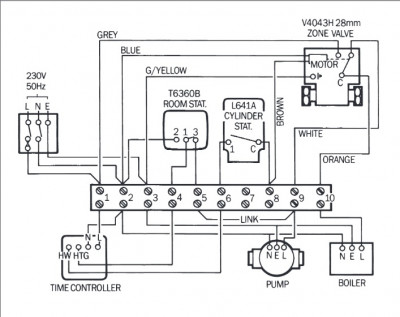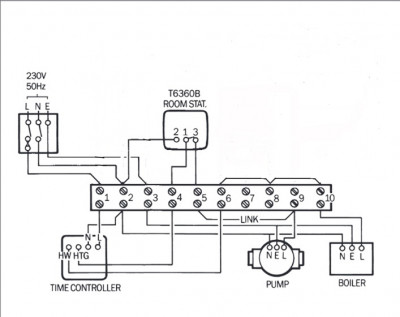by ericmark »
Tue Nov 20, 2018 1:04 pm
The main Nest unit could replace the Drayton LP711 and you will need to bridge the cables in old thermostat or turn it full on.
However there is likely a wiring centre, and if Nest replaces the wiring centre you may be able to use the old wires to thermostat to supply power to Nest thermostat.
Some how the control needs to cause boiler to either heat radiators or domestic hot water, or even simply heat domestic hot water at all times and switch heating on/off, in the main to do that we use a motorised valve.
There are very basic systems which were really designed more for back ground heat rather than full central heating, years ago that is how this house worked.
So 7 am the heating switched on and 10 am it switched off, if the wall thermostat in hall got warm enough it would turn pump off, leaving just thermo syphon for domestic hot water, however in real terms upstairs continued to heat up. But since switched off at 10 am not really a problem, around 5 pm it would fire up again for a couple of hours so off at 7 pm.
The coke followed latter by gas fires heated the main living room during day and evening, the central heating just removed the chill.
The domestic hot water got really hot, even with boiler running just 5 hours a day, and all the time programmer was on the boiler would cycle on/off even if thermostat showed room warm enough.
By adding a cylinder thermostat then one could leave the central heating on without it continually cycling, however domestic hot water was as hot as radiators, often 80 deg C rather than 55 deg C which is more normal today.
Next stage was add a motorised valve, then we could at last stop the tank getting stinking hot, and control central heating and domestic hot water at least to some extent independently. I say to some extent as central heating pump off once upstairs radiators were hot, they continued to be hot due to thermal syphon.
All the three stages were all called C Plan. Once you added a second motorised valve it was called S Plan.
There is also a system with a single motorised valve with three ports, and the W plan heats domestic hot water first (either two valves or a single three port valve) then it does central heating.
Or the Y Plan used a mid position three port valve, this does both domestic hot water and central heating at the same time.
I have not read how to program Nest for the different systems, but the old programmer had two options either 10 programs (no motorised valve) or 16 programs (with motorised valve) and often a mechanical and electrical stop and switch to change it from 10 to 16 programs. The basic fact was with early C plan there was no way you could have central heating without domestic hot water, you simply could not turn off domestic hot water without also turning off central heating.
I would guess Nest was never designed to work with the very old C plan, and if you don't have a motorised valve, adding a motorised valve must be your first job.
When done on installation the motorised valve is normally near the hot water cylinder, it makes the cabling to the cylinder thermostat easy, however when doing my dads central heating I wanted to keep running wires down to a minimum. So motorised valve fitted near boiler, and I used a wireless tank thermostat.
As it transpired the cold water tank started to leak soon after, so whole system was replaced with a combi boiler, so mod was short lived.[attachment=1]C-Plan_old2.jpg[/attachment]This is basic C Plan [attachment=0]C-Plan.jpg[/attachment] and this is with both tank thermostat and motorised valve added, hope pictures work never had much luck with pictures.
From what happened with my dads house, first thing to look at is if there are any other faults, I was rather peeved to have spent so much time and effort updating only to see it all ripped out when new boiler went in.
As to new boiler v old boiler not easy, whole idea of new boiler is to adjust output to match requirements where old boiler was simple on/off. I am not sure the best way to control new boiler, but if fitting a new one, I would say if it does not support OpenTherm reject it, there are so many options not open to you if it does not support OpenTherm I would say discount any boiler not supporting it.
-
Attachments
-

-



